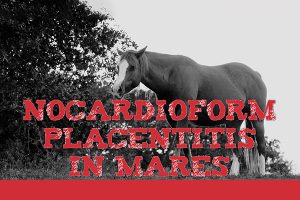Nocardioform Placentitis In Mares
Click here to read the complete article
290 – March/April, 2023
Some broodmares suffer late-term pregnancy losses due to placentitis (inflammation and infection of the placenta), making it the single most common cause of abortions, stillbirths, and loss of newborn foals. This results in multimillion-dollar losses in the equine breeding industry.
There are four recognized forms of equine placentitis: ascending, focal mucoid (nocardioform), diffuse (hematogenous), and multifocal placentitis. Ascending placentitis is the most frequent; the ascending infection (predominately caused by Streptococcus equi sub. zooepidemicus) gains access through the vagina and cervix. Multifocal and diffuse placentitis are less common and usually due to spread of microorganisms to the uterus via the bloodstream. A number of diseases may cause this type of infection, including leptospirosis and salmonellosis.
Mucoid or Nocardioform placentitis is a distinctly different type of equine placentitis, and characterized by focal infection of the chorionic surface leading to mucoid exudate and loss of placental exchange of nutrients in these areas.
Dr. Maria Schnobrich (LeBlanc Reproduction Center at Rood and Riddle Equine hospital in Kentucky) says Nocardioform placentitis has a characteristic presentation that is usually diagnosed in late gestation—from about 8 months to term. “It’s called a mucoid placentitis because there are some very large areas of placental destruction that are usually covered in a thick brown, mucoid material, with destruction of normal function of that portion of the placenta that interfaces with the uterus in these areas,” she explains.
“When a mare has this problem, often the only external sign you will see is that she is developing an udder too early, or she may abort, or the foal may be born at term (and might be normal). The characteristic lesion is a “peanut butter” consistency-looking material on the red velvety side of the placenta known as the chorioallantois,” says Schnobrich. The connection between the outer lining of the placenta and the uterine lining has been disrupted.
“What we see, depending on extent of the lesions, is that if the rest of the placenta has adequate exchange with minimal inflammation, it may not affect the foal at all. If there is too much disruption, however, and not enough contact for nutrient and oxygen exchange, the fetus may be starved and stunted, or may die,” she says.
Click here to read the complete article
290 – March/April, 2023











